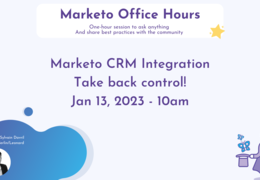Marketo Office Hours
Breaking Silos: How Marketo CRM Synchronization Transforms Sales and Marketing Strategies
83 views
Synchronization between Marketo and a CRM (Customer Relationship Management) system is a crucial aspect of any modern digital marketing strategy, providing an effective means of linking marketing efforts to sales results. In this article, we dive into the nuances of "Marketo CRM synchronization", highlighting its importance, how it works and the benefits it can bring to a business.
- 00:00 The end-to-end lifecycle. What happens when you acquire Marketing Automation in CRM? Definition of the Qualification / Enrichment / Conversion / Deduplication processes.
- 06:30 The difference between Lead and Contact. Why Marketing prefers to use the Lead to receive information from the Lead.
- 08:30 Question: can we send an alert to sales when a lead is converted?
- 12:25 The Revenue Cycle Model becomes available when synchronization is implemented.
- 13:20 Marketo's Program Analyzer and Revenue Attribution Engine
- 15:10 The Opportunity Influence Analyzer
- 16:36 How Marketo CRM synchronization works
- 18:50 Impact of synchro on Marketo fields
- 20:30 Question: I have MS dynamics and some fields are not mapped.
- 21:30 Possibility of remapping or merging fields with Marketo support
- 22:08 Choice of default synchronization parameters on the Marketo side
- 24:25 Marketo iframes to insert into CRMs and Interesting moments
- 25:50 Transferring people from MArketo to CRM and the Lead Life Cycle program
- 27:20 Filters, triggers and actions possible in CRM from Marketo thanks to synchro
- 30:00 Impact of partitions on the lead life cycle and scoring
- 31:30 Question: why only one campaign to drive leads to CRM? and key management between Marketo and CRM
- 37:48 Question: what happens if a sales rep adds a person to a Salesforce campaign that is synchronized with Marketo?
- 41:19 Salesforce - Marketo custom object synchronization - Quizzes example
The Crucial Importance of Synchronization
Marketo CRM synchronization plays a vital role in ensuring that marketing and sales teams work from the same information, enabling a unified approach to the customer journey. This harmonization ensures that marketing efforts are aligned with sales objectives, reinforcing the overall effectiveness of customer engagement strategies
Synchronization mechanisms
At the heart of Marketo CRM synchronization is the exchange of data between Marketo, a marketing automation platform, and the CRM system used by the sales team. This integration enables bi-directional data communication, ensuring that relevant information on leads and customer interactions is shared and updated in real time between the two systems.
Tangible benefits of integration
- Optimized lead management: Integration enables precise lead classification and scoring, helping sales teams to focus on the most promising prospects, and thus increasing the chances of conversion.
- Targeted marketing campaigns: With direct access to sales data, marketers can design highly personalized campaigns that resonate with prospects' needs and preferences, increasing engagement and conversion rates.
- In-depth analysis: Marketo CRM integration makes it easy to track and analyze the effectiveness of marketing campaigns, enabling clear attribution of revenues to specific marketing activities and a better understanding of ROI.
Tips for successful synchronization
- Data cleansing: Ensure that data in both systems is clean and well-organized before synchronizing, to avoid errors and duplication.
- Define processes: Establish clear processes for the transfer and management of leads between the marketing and sales teams, ensuring that each team understands its role in the lead lifecycle.
- Ongoing monitoring: Once synchronization is in place, it's vital to regularly monitor the flow of data between Marketo and CRM to quickly identify and resolve potential problems.
Challenges to overcome
Synchronization between Marketo and a CRM can present challenges, particularly in terms of change management and interdepartmental communication. To overcome these challenges, it is advisable to maintain open lines of communication between the marketing and sales teams, and to engage in ongoing training to ensure that all team members understand how to get the most out of the integration.
Conclusion
Marketo CRM synchronization is an essential component of an effective digital marketing strategy, enabling better collaboration between marketing and sales teams and offering a holistic view of the customer journey. By implementing seamless integration and following best practices, companies can maximize the effectiveness of their marketing efforts, improve conversion rates and increase the ROI of their marketing campaigns.







December 29, 2025 12:15 PM Delete
This unique seems to be thoroughly ideally suited. Each one of minor essentials are produced alongside large amount of story knowledge. I’m a for the considerably. togel 4d
December 29, 2025 12:14 PM Delete
I can’t believe focusing long enough to research; much less write this kind of article. You’ve outdone yourself with this material without a doubt. It is one of the greatest contents. togel 4d
인천 셔츠룸 December 29, 2025 11:45 AM Delete
도심 속 숨겨진 인천 셔츠룸를 선택해보세요 오랜만에 만족한 장소였어요
구로구호빠 December 29, 2025 09:48 AM Delete
기분 전환이 필요한 날 찾게 되는 구로구호빠를 찾아보세요 선곡이 참 좋았어요
강남 룸알바 December 29, 2025 07:58 AM Delete
더 이상 부모님께 손 벌리기 싫어서 강남 룸알바에서 일하면서 자신감도 얻었어요 이 일로 자신감을 많이 얻었어요
대구 보도사무실 December 29, 2025 06:07 AM Delete
소개팅 장소로 추천되는 대구 보도사무실를 선택해 보는 것도 좋아요 평화로웠어요
강남호빠 December 29, 2025 04:13 AM Delete
트렌디한 감성의 강남호빠를 만나러 가보세요 하루가 힐링됐어요
강북호빠 December 29, 2025 02:14 AM Delete
트렌디한 감성의 강북호빠에서 소소한 행복을 느껴보세요 굉장히 만족스러웠어요
December 28, 2025 01:35 PM Delete
Hello! I recently wish to give a enormous thumbs up for your great information you’ve got here for this post. I’ll be coming back to your website for additional soon. omacuan
December 28, 2025 01:34 PM Delete
Came clueless, left worried. Thanks for the post. Sometimes I wonder whether the planet is being run by smart people who are putting us on or by imbeciles who really mean it. omacuan game online
December 28, 2025 11:17 AM Delete
This unique seems to be thoroughly ideally suited. Each one of minor essentials are produced alongside large amount of story knowledge. I’m a for the considerably. omacuan login
December 28, 2025 11:16 AM Delete
I can’t believe focusing long enough to research; much less write this kind of article. You’ve outdone yourself with this material without a doubt. It is one of the greatest contents. omacuan login
오피스타 December 27, 2025 02:38 PM Delete
I just found this blog and have high hopes for it to continue. Keep up the great work, its hard to find good ones. I have added to my favorites. Thank You. slot gacor
December 27, 2025 01:52 PM Delete
Wow that was odd. I just wrote an incredibly long comment but after I clicked submit my comment didn’t appear. Grrrr… well I’m not writing all that over again. Anyhow, just wanted to say excellent blog! toto 4d
December 27, 2025 01:51 PM Delete
An impressive share, I simply with all this onto a colleague who was simply carrying out a little analysis for this. And that he in truth bought me breakfast since I ran across it for him.. smile. So i want to reword that: Thnx for the treat! But yeah Thnkx for spending some time to talk about this, I feel strongly concerning this and love reading regarding this topic. Whenever possible, as you become expertise, do you mind updating your blog post with an increase of details? It truly is highly a good choice for me. Big thumb up due to this post! toto 4d
December 27, 2025 12:40 PM Delete
This is very useful, although it will be important to help simply click that web page link: login ayamtoto
December 27, 2025 12:37 PM Delete
However you might get started it is vital, the item all over again yields a website a robust major site: ayam toto
December 27, 2025 12:33 PM Delete
Useful in addition to useful facts can be located within this subject matter in this article page value to discover the item. login ayamtoto
December 27, 2025 12:30 PM Delete
With the web page you'll see identical texts, generate whatever you imagine. ayam toto
오피스타 December 27, 2025 11:26 AM Delete
This is a smart blog. I mean it. You have so much knowledge about this issue, and so much passion. You also know how to make people rally behind it, obviously from the responses. keytoto alternatif
순천호빠 December 26, 2025 06:19 PM Delete
피로를 잊게 해주는 순천호빠를 예약해보세요 후회 없었어요
연산동호빠 December 26, 2025 04:32 PM Delete
즐거운 시간을 보낼 수 있는 연산동호빠에 다녀와보세요 이야기 나누기 좋았어요
안양호빠 December 26, 2025 02:48 PM Delete
기분 전환이 필요한 날 찾게 되는 안양호빠를 발견해보세요 기대 이상이었어요
용인호빠 December 26, 2025 01:05 PM Delete
이야기를 나누기 좋은 용인호빠에 방문해서 분위기를 즐겨보세요 평화로웠어요
창원호빠 December 26, 2025 11:21 AM Delete
도심 속 숨겨진 창원호빠에서 소소한 행복을 느껴보세요 진짜 감성적이었어요
건대호빠 December 26, 2025 09:34 AM Delete
조용한 분위기의 건대호빠에서 새로운 추억을 만들어보세요 굉장히 만족스러웠어요
부천호빠 December 26, 2025 07:45 AM Delete
낭만적인 분위기의 부천호빠에서 편하게 즐겨보세요 시간이 금방 갔어요
강남더킹 December 26, 2025 06:01 AM Delete
평범한 일상에서 벗어나기 좋은 강남더킹를 선택해 보는 것도 좋아요 마음이 편해졌어요
대전 노래방알바 December 26, 2025 04:11 AM Delete
단순 반복적인 일이 싫어서 대전 노래방알바를 시작하게 됐는데 분위기가 나쁘지 않았어요 이 일로 자신감을 많이 얻었어요
수유 노래방알바 December 26, 2025 02:24 AM Delete
기회는 지금뿐이라 생각해서 수유 노래방알바에 들어가면서 고정 수입이 생겼어요 생활이 훨씬 편해졌어요
December 25, 2025 12:34 PM Delete
Heard about this website from my buddy. He pointed me here and informed me I’d discover what I need. He was right! I got all of the questions I had, answered. Did not even take lengthy to seek out it. Love the truth that you produced it so simple for individuals like me. api777 situs
December 25, 2025 12:33 PM Delete
I just now wanted to inform you about how much I appreciate every thing you’ve contributed to help increase the value of the lives of people in this theme. api777 link
December 25, 2025 12:32 PM Delete
It is best to largely remarkable combined with well-performing stuff, so find it: ayamtoto slot
December 25, 2025 12:26 PM Delete
With of which web page webpage, you'll see ones account, you could start to went through that. ayamtoto
December 25, 2025 08:44 AM Delete
“Greetings! Very helpful advice on this article! It is the little changes that make the biggest changes. Thanks a lot for sharing!” iosbet login
달서구 노래방알바 December 24, 2025 06:35 PM Delete
혼자서 자립해보려고 달서구 노래방알바를 시작하고 경제적으로 안정됐어요 다른 사람에게도 추천하고 싶어요
Dave Jack December 24, 2025 05:02 PM Delete
소액대출은 급하게 현금이 필요할 때 빠르고 간편하게 자금을 마련할 수 있는 대표적인 방법입니다. 큰 금액이 아니어서 비교적 짧은 기간 내 상환하는 경우가 많고, 신청 소액대출
광주호빠 December 24, 2025 04:47 PM Delete
가성비 좋은 광주호빠에서 하루를 마무리해보세요 사진도 잘 나왔어요
Dave Jack December 24, 2025 04:06 PM Delete
일산출장마사지 서비스는 일산광역시 전역에서 편안하게 전문 마사지를 받을 수 있는 출장 홈타이 서비스입니다. 고객님이 계신 곳으로 여성 전문 테라피스트가 직접 일산출장마사지
오피스타 December 24, 2025 04:00 PM Delete
Thanks for posting this info. I just want to let you know that I just check out your site and I find it very interesting and informative. I can't wait to read lots of your posts. slot gacor
의정부호빠 December 24, 2025 02:54 PM Delete
음악이 좋은 의정부호빠를 경험해보세요 오래 머무르고 싶었어요
해운대호빠 December 24, 2025 01:01 PM Delete
낭만적인 분위기의 해운대호빠를 추천드려요 의외로 넓고 쾌적했어요
December 24, 2025 12:09 PM Delete
This is very pleasing, even so, it's very important that can computer mouse button click the network: 광명출장마사지
Dave Jack December 24, 2025 12:05 PM Delete
오늘 제주출장마사지 제주출장안마. #제주출장마사지 #제주출장안마 #20대관리사 #후불제. 예약문의 010-0000-0000. 2025년 정상 영업중입니다. 제주출장마사지
December 24, 2025 12:00 PM Delete
It is best to largely remarkable combined with well-performing stuff, so find it: 천안출장마사지
December 24, 2025 11:54 AM Delete
It truly is remarkable, even so, look into stuff for the neighborhood target. 평택출장마사지는
대전호빠 December 24, 2025 11:14 AM Delete
트렌디한 감성의 대전호빠를 발견해보세요 또 가고 싶어요
수유호빠 December 24, 2025 09:26 AM Delete
스토리가 느껴지는 수유호빠를 꼭 한 번 가보세요 소문대로였어요
유성호빠 December 24, 2025 07:37 AM Delete
인생샷 건지기 좋은 유성호빠에서 감성을 느껴보세요 여유롭게 보낼 수 있었어요
진주호빠 December 24, 2025 05:49 AM Delete
도심 속 숨겨진 진주호빠에 다녀오는 걸 추천드려요 느낌이 참 좋았어요
부평호빠 December 24, 2025 04:02 AM Delete
재방문하고 싶은 부평호빠를 선택해 보는 것도 좋아요 정말 힐링했어요
천안노래방 December 24, 2025 02:13 AM Delete
평범한 일상에서 벗어나기 좋은 천안노래방를 즐기기 딱 좋아요 마음이 편해졌어요
December 23, 2025 11:28 AM Delete
Thanks for another informative web site. Where else could I get that kind of information written in such an ideal way? I’ve a project that I’m just now working on, and I have been on the look out for such information. bandar toto macau
December 23, 2025 11:27 AM Delete
Aw, it was a very good post. In concept I have to put in place writing similar to this additionally – taking time and actual effort to create a good article… but so what can I say… I procrastinate alot by no indicates often get something completed. toto macau
December 23, 2025 08:40 AM Delete
The look rightly terrific. All these mini advice happen to be created implementing massive amount past working experience. I'd like to see the whole works very much. toto macau
December 23, 2025 08:39 AM Delete
Thanks for sharing this information. I really like your blog post very much. You have really shared a informative and interesting blog post with people.. bandar toto
천안노래방 December 22, 2025 06:53 PM Delete
차분한 공간이 필요한 날 어울리는 천안노래방에서 특별한 하루를 보내보세요 모든 게 완벽했어요
수원가라오케 December 22, 2025 05:00 PM Delete
핫플레이스로 떠오르는 수원가라오케에서 분위기를 느껴보세요 정말 편안했어요
December 22, 2025 03:51 PM Delete
The look rightly terrific. All these mini advice happen to be created implementing massive amount past working experience. I'd like to see the whole works very much. linkdewibola.com
December 22, 2025 03:50 PM Delete
Thanks for sharing this information. I really like your blog post very much. You have really shared a informative and interesting blog post with people.. linkdewibola.com
강남미션 December 22, 2025 03:04 PM Delete
감탄이 절로 나오는 강남미션를 즐기기 딱 좋아요 굉장히 만족스러웠어요
강남호빠 December 22, 2025 01:17 PM Delete
새로운 경험을 주는 강남호빠에 가보세요 사진도 잘 나왔어요
December 22, 2025 12:53 PM Delete
Merely a smiling visitant here to share the love (:, btw outstanding style. 아산출장마사지
December 22, 2025 12:49 PM Delete
If you set out to make me think today; mission accomplished! I really like your writing style and how you express your ideas. Thank you. 아산출장마사지
December 22, 2025 11:35 AM Delete
Hello! I know this is kinda off topic but I was wondering if you knew where I could locate a captcha plugin for my comment form? I’m using the same blog platform as yours and I’m having problems finding one? Thanks a lot! oma cuan
December 22, 2025 11:34 AM Delete
I like what you guys are up also. Such intelligent work and reporting! Keep up the superb works guys I have incorporated you guys to my blogroll. I think it’ll improve the value of my web site omacuan
강남호빠 December 22, 2025 11:31 AM Delete
오래 머무르고 싶은 강남호빠에서 하루 종일 있어도 좋아요 여유롭게 보낼 수 있었어요
Dave Jack December 22, 2025 09:44 AM Delete
Hi there, i read your blog occasionally and i own a similar one and i was just curious if you get a lot of spam feedback? If so how do you stop it, any plugin or anything you can suggest? I get so much lately it’s driving me crazy so any support is very much appreciated. Luxury small boat Nile cruise
군산호빠 December 22, 2025 09:41 AM Delete
가성비 좋은 군산호빠에 들러 추억을 만들어보세요 평화로웠어요
December 22, 2025 08:15 AM Delete
Thanks for another informative web site. Where else could I get that kind of information written in such an ideal way? I’ve a project that I’m just now working on, and I have been on the look out for such information. api777 situs
December 22, 2025 08:14 AM Delete
Aw, it was a very good post. In concept I have to put in place writing similar to this additionally – taking time and actual effort to create a good article… but so what can I say… I procrastinate alot by no indicates often get something completed. api777 link
해운대호빠 December 22, 2025 07:53 AM Delete
도심 속 힐링 공간인 해운대호빠를 발견해보세요 모든 게 완벽했어요
안양시 노래방알바 December 22, 2025 06:09 AM Delete
진짜 내 인생을 살기 위해 안양시 노래방알바를 통해서 안정적인 수입을 얻고 있어요 경제적으로 독립할 수 있게 됐어요
안양호빠 December 22, 2025 04:16 AM Delete
인생샷 건지기 좋은 안양호빠에서 여유를 느껴보세요 감성에 취했어요
해운대 룸빠 December 22, 2025 02:24 AM Delete
소문난 명소로 알려진 해운대 룸빠에서 분위기를 느껴보세요 완전 만족했어요
December 21, 2025 04:00 PM Delete
This unique looks utterly perfect. Every one of plain and simple records are prepared through the help of great number for working experience handy experience. I will be happy it all for a second time considerably. oma cuan
December 21, 2025 03:59 PM Delete
I think this is one of the most significant information for me. And i’m glad reading your article. But should remark on some general things, The web site style is perfect, the articles is really great : D. Good job, cheers omacuan link
qumar farooq December 21, 2025 01:28 PM Delete
hello there and thanks in your info – I have definitely picked up something new from right here. I did on the other hand expertise some technical points using this site, as I experienced to reload the website a lot of times previous to I may get it to load properly. I had been puzzling over in case your web host is OK? No longer that I’m complaining, but slow loading instances times will often impact your placement in google and can injury your quality score if advertising and ***********|advertising|advertising|advertising and *********** with Adwords. Well I’m including this RSS to my email and could look out for a lot extra of your respective exciting content. Ensure that you replace this again very soon.. my blog
nagaspin99 slot December 21, 2025 01:18 PM Delete
I simply had to thank you very much yet again. I am not sure the things that I would have sorted out in the absence of the tactics documented by you regarding such area. It was before a real challenging scenario in my view, however , discovering a new well-written technique you handled it forced me to cry over joy. I’m just grateful for this support and as well , pray you realize what an amazing job you’re doing teaching the others with the aid of your webpage. I’m certain you haven’t encountered all of us. nagaspin99 slot
December 21, 2025 10:57 AM Delete
I am interested in types write-up. It really is good for uncover individuals explain in words about the heart along with knowing in this substantial style is generally merely found. situs slot
December 21, 2025 10:49 AM Delete
I enjoy each one of the posts, We appreciated, I would enjoy a lot more info with this particular, due to the fact it's very enjoyable., Be thankful meant for providing. situs slot
대전출장마사지 December 21, 2025 06:01 AM Delete
https://djswedish.isweb.co.kr/ 대전스웨디시
Dave Jack December 20, 2025 07:16 PM Delete
I think other website proprietors should take this site as an model – very clean and wonderful style and design, not to mention the content. You’re an expert in this topic! how long do college football games last
December 20, 2025 03:48 PM Delete
Useful in addition to useful facts can be located within this subject matter in this article page value to discover the item. Jobs Update UAE
December 20, 2025 03:45 PM Delete
Most of these you will then view the most important thing, the appliance delivers that you web page an excellent significant internet page: Jobs Update UAE
December 20, 2025 01:16 PM Delete
I'd personally advocate just effective together with honest truth, and for that reason realize its: 군포출장마사지
December 20, 2025 01:09 PM Delete
I'd personally advocate just effective together with honest truth, and for that reason realize its: 다낭유흥
December 20, 2025 01:02 PM Delete
Within this theme internet page, you'll see the very best facts, you'll want to watch over that higher level of aspect. 일본유흥
December 20, 2025 12:54 PM Delete
It is best to in essence excellent in addition to stable tips, which suggests see: 군포출장마사지
December 20, 2025 12:45 PM Delete
It is best to in essence excellent in addition to stable tips, which suggests see: 다낭유흥
December 20, 2025 12:38 PM Delete
It is best to in essence excellent in addition to stable tips, which suggests see: 일본유흥
Surron ultra bee December 20, 2025 11:45 AM Delete
I read a article under the same title some time ago, but this articles quality is much, much better. How you do this.. jerukbet
Surron ultra bee December 20, 2025 11:44 AM Delete
I read a article under the same title some time ago, but this articles quality is much, much better. How you do this.. jerukbet
Dave Jack December 20, 2025 09:05 AM Delete
비아그라 구매 — 정품 확인부터 안전한 구매까지! 비아스토어는 정품 인증 제품만을 취급하며, 고객님의 사생활을 지켜주는 100% 비밀 포장 배송 시스템을 제공합니다. 비아그라 구매
Dave Jack December 20, 2025 08:35 AM Delete
의왕출장마사지는 호텔, 자택, 오피스 등 어디서나 받을 수 있는 방문형 전문 마사지 서비스입니다. 아로마, 스웨디시, 스포츠, 림프, 풋마사지까지 — 의왕 전역 출장 의왕출장마사지
December 20, 2025 08:10 AM Delete
I impressed, I must say. Actually not often do I encounter a blog that both educative and entertaining, and let me tell you, you have hit the nail on the head. Your idea is excellent; the problem is one thing that not enough people are talking intelligently about. I’m very pleased that I stumbled across this in my seek for one thing relating to this. Bariatric Gelatin Recipe
Dave Jack December 20, 2025 07:58 AM Delete
군포출장마사지는 호텔, 자택, 오피스 등 어디서나 받을 수 있는 방문형 전문 마사지 서비스입니다. 아로마, 스웨디시, 스포츠, 림프, 풋마사지까지 — 군포 전역 출장 군포출장마사지
대전출장마사지 December 20, 2025 06:49 AM Delete
https://djswedish.isweb.co.kr/ 대전스웨디시
대전출장마사지 December 20, 2025 12:15 AM Delete
https://djswedish.isweb.co.kr/ 대전스웨디시
Dave Jack December 19, 2025 08:23 PM Delete
천안출장마사지는 호텔, 자택, 오피스 등 어디서나 받을 수 있는 방문형 전문 마사지 서비스입니다. 아로마, 스웨디시, 스포츠, 림프, 풋마사지까지 — 천안 전역 출장 천안출장마사지